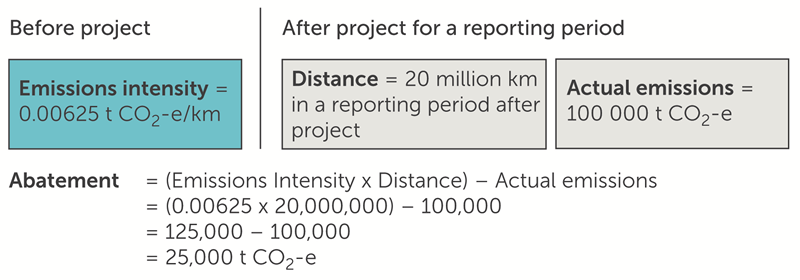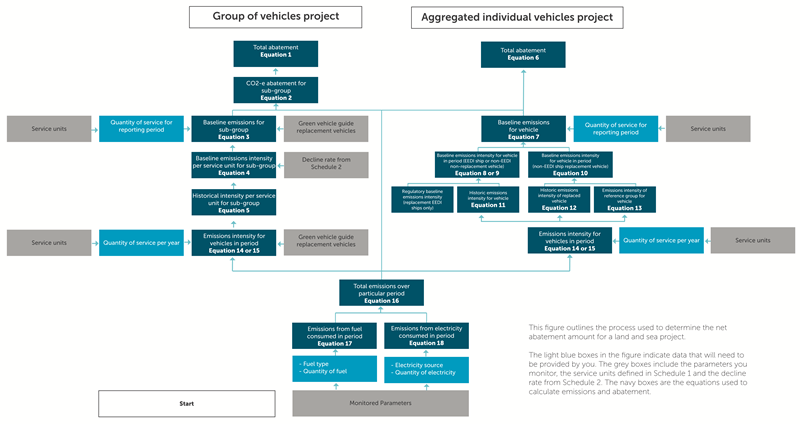How a land and sea transport project is set up and run is critical for calculating the amount of emissions avoided as a result of a project, which in turn determines the amount of abatement that has occurred and how many ACCUs can be issued for a project. Parts 3 and 4 of the method and explanatory statement describe in detail the project requirements and how to calculate the volume of emissions avoided, as well as the net abatement that has occurred. When considering whether running a land and sea transport would benefit your business you should familiarise yourself with how abatement is calculated under the method and use the same process to estimate possible abatement.
Setting up and running a land and sea transport project can be divided into the following parts. Each part refers to the relevant sections of the method, which explain the project in more detail.
Remember to download a copy of the explanatory statement to read along with the land and sea transport.
Remember to download a copy of the explanatory statement to read along with the land and sea transport.
Establish the land and sea transport project
You first need to determine which type of project to use; a group of vehicles project or an aggregated individual vehicles project. The type of project you choose will depend on your type of business operation and what historical data you have available. You will then need to work out which vehicles to include and which emissions reductions activities to perform.
Light Vehicles – Green Vehicle Guide
Note that for light vehicles in which fuel data cannot be monitored, such as hire cars, the baseline emissions intensity can instead be set using the Australian Government’s Green Vehicle Guide (Section 28 in the method). In these cases, the only eligible project activity is vehicle replacement, because reductions in fuel use due to other activities cannot be measured. Data from the Green Vehicle Guide is used when calculating the emissions intensity (Equation 15 in Figure 1).
If using the Green Vehicle Guide to calculate the net abatement amount, the following information must also be provided in each offsets report: the details (make, model and fuel type) of the vehicles; any details of replacement vehicles; evidence of the replacement.
A group of vehicles project involves implementing project activities and monitoring emissions reductions at the level of all the vehicles in a vehicle sub-group (Section 11 in the method). Each sub-group contains all vehicles of the same vehicle category in a business unit or transport operation. Light vehicles, trucks, buses, trains and marine vessels sub-groups can be included, but mobile equipment is excluded (e.g. off road self-propelled machinery). Light vehicles must use this project type. Section 12 of the method describes the information you must provide for each sub-group of vehicles when applying to run a group of vehicles project.
An aggregated individual vehicles project may involve one or more vehicles (Section 14 in the method), but not necessarily all the vehicles in a sub-group of a business unit or transport operation. Where multiple vehicles are included, they may belong to different vehicle categories. Trucks, buses, trains, marine vessels and mobile equipment can be included, but light vehicles are excluded. This is the project type to use for mobile equipment. Section 15 of the method describes the information you must provide when applying to register this type of project. To allow for shorter applications, you may provide the information by class of vehicle, rather than by individual vehicle.
You need to choose the service unit that best reflects the vehicles used in your project and include these in your project application.
Emissions intensity and service units
Emissions intensity is a measure of the level of emissions produced per unit of transport services provided. Emissions are always measured in tCO2-e. Transport service is measured using different service units.
Check the method to determine which service units are applicable to the vehicle categories in your project. The service units for vehicle categories are set out in Schedule 1 and defined in section 5 of the method. The number of passengers can be converted into cargo weight by using a conversion factor of 78kg for each passenger (see section 16 of the method).
For most vehicle categories, participants may choose from a selection of service units to measure emissions intensity. For example, the emissions intensity of passenger transport can be measured as emissions per passenger kilometre* (tCO2-e/pkm), whereas the intensity of freight transport can be measured as emissions per tonne kilometre (tCO2-e/tkm). For some vehicle categories there is no choice of service unit.
*A passenger kilometre is the carriage of a single passenger over a distance of one kilometre. It is calculated by multiplying the number of passengers carried over the number of kilometres travelled. So, a bus that carried 50 people for 100 kilometres would have performed 5000 passenger kilometres.
Mode switching in land and sea transport projects
Transport mode switching refers to changing between vehicle categories (e.g. between rigid trucks and rail freight). In the context of the current emissions reduction fund land and sea transport method, a mode shift project is possible only where a proponent conducts operations across both vehicle categories and providing that the duty cycle of the replacement vehicle is the same as the replaced vehicle. Any abatement created is not based on the difference in emissions intensity between categories of vehicles. Rather, abatement is created by improvements in emissions intensity within the categories of vehicles involved in the project. Under the current method mode switching projects are unlikely to result in the creation of abatement.
Participants are advised to note the following when assessing the benefit of including mode switching activities:
- The replaced vehicle must be sold or disposed of within 90 days of the first use of the replacement vehicle (as per 24 (1) (a) (ii) of the method).
- Careful consideration needs to be given to the potential amount of abatement possible using mode switching, given that the baseline is calculated using the lower of:
- the lowest of the previous 3 years’ emissions intensity of the replaced vehicle (see subsection 24(5) of the method), and
- the lowest of the average emissions intensity over the previous 3 years of each vehicle in a reference group comprised of vehicles in the same vehicle category as the replacement vehicle which were used within the transport operation of the participant (see subsection 24(6) of the method).
This means that unless the replacement vehicle is significantly more efficient than the vehicles in the reference group, abatement may be zero.
To meet the requirements of the method, participants will need to ensure that they have access to three years of relevant historical data required to calculate project baseline emissions intensity (e.g. amount of fuel consumed, distances travelled, tonnage), this may be complex where the new mode of transport is not owned or operated by the participant. The land and sea transport method does not allow for this historical data to be modelled so actual data must be available.
Calculate emission reductions
Figure 1 – Calculating abatement, simple example

There are several steps involved in calculating the net emissions reductions from the project and these are discussed below. Figure 1 shows the key steps and equations used.
What’s tCO2-e?
CO2-e is a measure of the warming effect of different greenhouse gases that allows them to be compared to the equivalent amount of carbon dioxide. It refers to the amount of carbon dioxide that would give the same warming effect as each greenhouse gas that is emitted or stored by an activity.
Calculate project baseline emissions intensity
To calculate the project baseline, you first need to determine the baseline emissions intensity for each sub-group of vehicles or individual vehicle. The process can be broken into the following five steps.
- Determine emissions intensity for three previous years.
- Use the lowest historic intensity to determine baseline emissions.
- For the reporting period calculate abatement by subtracting the actual emissions from the baseline emissions.
- Apply decline rate if a group of vehicles project.
- If the abatement calculated is negative the abatement is considered to be zero.
Calculate baseline emissions
As for the baseline emissions intensity, calculating the baseline emissions depends on the type of project.
For a group of vehicles project, baseline emissions must be calculated for each sub-group separately, because each sub-group will have a different baseline emissions intensity and level of service. The baseline emissions are calculated by multiplying the sub-group’s baseline emissions intensity by the quantity of transport service in a reporting period (see Subsection 21(3) and Equation 3 in the method).
For an aggregated individual vehicles project, you will need to work out baseline emissions for each vehicle. This is calculated by multiplying the baseline emissions intensity of the vehicle by the quantity of transport service in a reporting period (see Subsection 24(2) and Equation 7 in the method).
Calculate emissions from the project
Every project needs to take into account emissions that arise from running it (see Part 4 in the method). This is to ensure these emissions are included in calculations that determine net abatement for a reporting period and crediting period.
For land and sea transport projects, the greenhouse gases that are accounted for in the calculations are listed in Section 18 of the method. Emissions sources that must be included are transport fuel use and electricity when it is used as a transport energy source. For an explanation of the sources of greenhouse gas that are excluded from the calculations, see Section 18 in the explanatory statement.
The project emissions for a reporting period are calculated using Equations 16–18 (see also Section 25 in the method) by working out the total emissions from:
- all vehicles within a sub-group, for a group of vehicles project
- individual vehicles, for an aggregated individual vehicles project.
Calculating the net amount of abatement and number of ACCUs
This is the final step in the calculations to determine the number of ACCUs that may be issued for a reporting period. At this stage the total emissions avoided by the project are calculated and then converted to tCO2-e (Sections 21 & 24 and equations 1, 2 and 6 of the method).
Abatement is calculated by subtracting the project emissions from the baseline emissions for each sub-group or individual vehicle. Where a sub-group or individual vehicle results in negative abatement, the abatement for that sub-group or vehicle is set as zero.
For a group of vehicles project, total net abatement is the sum of abatement across all sub-groups (Section 21 in the method). For an aggregated individual vehicles project, total net abatement is the sum of abatement across all individual vehicles (Section 24 in the method).
Figure 2 – Equations used to calculate abatement
